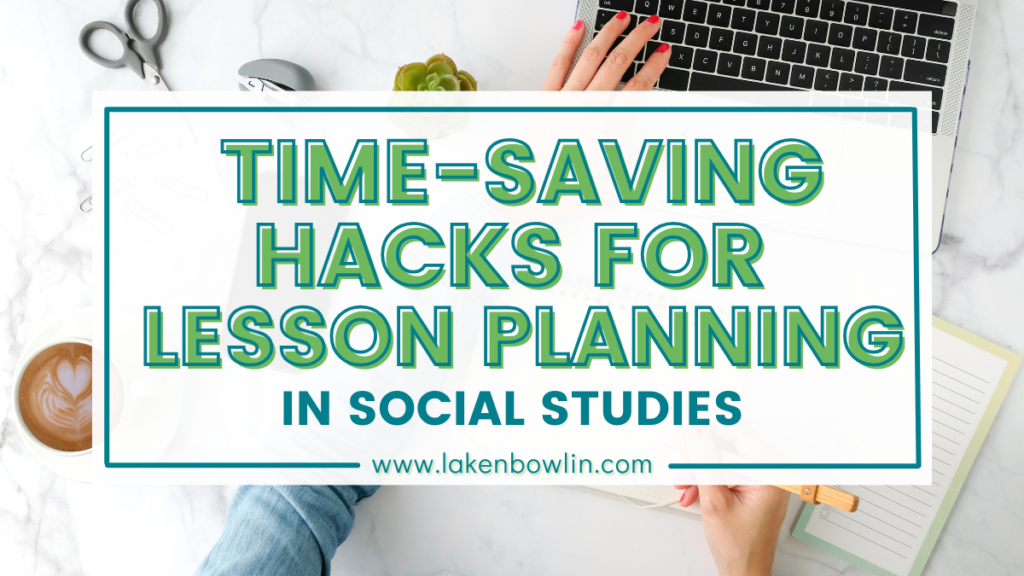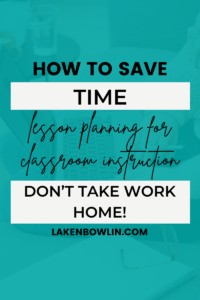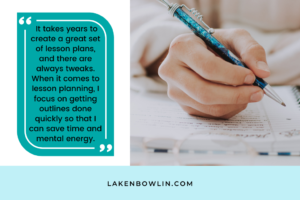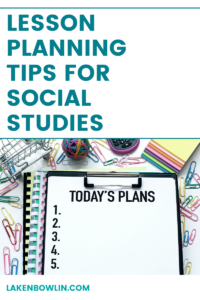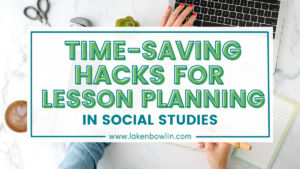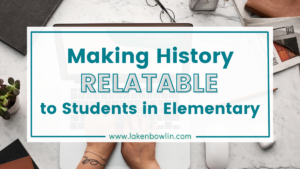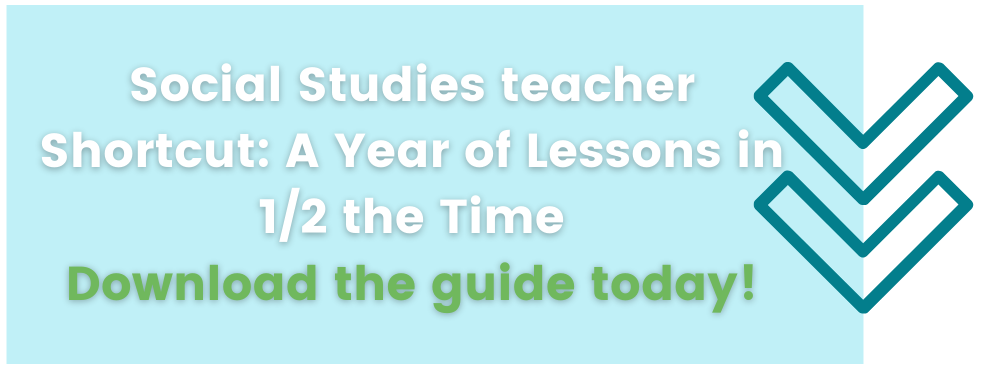Lesson planning was honestly one of the scariest parts of starting out as a new teacher. There was so much work to do, and while I had great coworkers who helped by sharing some of their plans and activities, it took a lot of time for me to develop my own set of lesson plans. And even though I’ve been teaching for several years, there are always “tweaks” I need to make to lesson plans year-to-year. When it comes to lesson planning, I focus on getting outlines done quickly so that I can save time and mental energy. So how do I save time with lesson planning? Read on!
Are you looking for planning resources that are easy to use, minimal prep, and ready at your fingertips? I have created a planning document for upper-elementary social studies teachers, and you are definitely going to want to go check it out! 👀 I have pacing, linked resource ideas, and essential questions ready to go for you. If you teach in the upper elementary classroom, there is something for you in that document. What are you waiting for? Go check it out HERE!
Save time by using templates
I had a bad habit early on writing every possible detail into my lesson plans. And that was just silly. First of all – nothing goes exactly as the lesson plan says. Second, I wasted so much time putting a lot of effort into something that I only glanced at throughout the day to keep focused. In the few instances, I had someone ask for my lesson plans, they thumbed through it and really glossed over it to look for a few key points.
What I’m saying is, use an outl
ine or a template that will allow you to plug in information quickly. This way you can pop in activities where you normally have them, and stick to important points that keep you on time and focused. When you use a template, all of your information will always be in the same place – making it easier to glance through and find what you are looking for. And templates or organiz
ed outlines are so great for subs and emergency plans – they look neat and put together. I find it so much easier to get the process of lesson planning going by using one, which is why I’m excited to share with you a template freebie that you can find here.
Follow a Guide to Save Time Lesson Planning
This is a perfect pairing for using a template. If you know what specific tasks you’d like to do every day, or activities you will use often – create a guide and go from there. I know I like to start with bellringers, and I usually throw in creative writing options throughout my units. So when I begin writing my lesson plans or design my template, there are designated spots for that information. I can immediately go through and plan for those types of activities.
When I create a familiar guide to my lesson plans, my school day becomes cohesive and predictable. Which means my students are able to predict what will happen next, and are prepared for the routine of my classroom. Trust me, create a guide for how you want the “flow” of your day to go, and use that when making your lessons.
Lesson Plan by focusing on content and NOT material prep
I think we all can agree that our plan periods could be a little longer. But since it isn’t, make sure you are using your plan time to actually plan out the content instead of focusing on copies and other tasks. I know, I know. “But that stuff still has to be done!”
When I have a list of the zillion things I need to do during plan time, I don’t get as much done. I spend my whole hour running around the building, wasting time leaving voicemails, trying to also think about the copies needed, etc. Instead, I have chosen to focus my plan period on actual planning. It is a singular task that I put all my mental energy into. It saves time because I’m blocking that entire task into one designated time frame. It’s “written in stone”. Then, when I finish my lessons, I can do other tasks with a mental lift and a giant checkmark on lesson planning.
Save time by organizing units
Instead of thinking of your lesson plans as “day by day” – organize by unit. Chunk the whole unit into one planning session, and spread out your activities in the timeframe you’ve designated for the unit. I mostly stick to 6-8 weeks per unit. I look at all the space I have for that unit and start filling in my lesson plans. I can see the big picture of what needs done, like if I can’t fit in all the activities I want or if I don’t have enough prep time before my students start a writing project. If I have something new I want to add in like a film, I can see where it may fit or what needs moved to make room.
That birds-eye view is a lifesaver so that I don’t spend too much time in one unit and then run out of time for others. I also use this tip as a reminder to check my calendar for school activities that sometimes sneak up on me. It’s terrible to make these great plans and then remember a field day is scheduled, or an assembly is coming up. I take those activities into account too.
Save time lesson planning by making notes.
Whether you’re an old-school paper and pencil person or if you love organizing your lessons digitally, make space for notes. And then use that space. It might seem like added work, because you will need to revisit your lesson plan. But in the long run you are doing yourself a huge favor. Taking the time to write down what went well or what didn’t means that next year you can tweak and not make the same mistakes every year. I certainly don’t remember all the details by the following year, so I depend on my notes to help me continuously improve my lessons. This includes things like adjusting time for students to complete activities, that types of questions students ended up having, what was boring, what was a big hit, and other valuable insight I would otherwise forget.
If you love the idea of saving time on your lesson planning, but feel like the task is still daunting, check out my planning guide for upper elementary social studies. It is packed with resources in one easy-to-use document. If you need ideas for videos, essential questions, and materials to make your planning a breeze, you don’t want to miss out on this resource. You don’t have to be overwhelmed when it comes to lesson planning.
Related Articles
Making Social Studies Lessons Relatable
Websites for Career Research: 5 Sites for Empowering Upper Elementary Students
